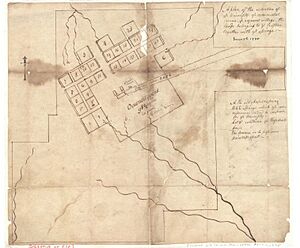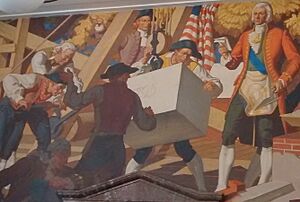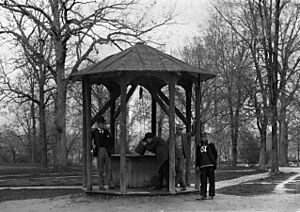History of the University of North Carolina at Chapel Hill facts for kids
The University of North Carolina at Chapel Hill is a large public university in Chapel Hill, North Carolina, United States. It's often called UNC Chapel Hill. It was one of the first public universities in the country. The school opened its doors on February 12, 1795.
For a long time, it was just known as the University of North Carolina. Later, in the 1970s, other state universities joined to form a bigger system. To tell them apart, the original school became the University of North Carolina at Chapel Hill.
Contents
Starting the University: Late 1700s
After the United States became independent, North Carolina wrote its own constitution in 1776. This constitution said that the state should create affordable schools and universities. These schools would help educate young people.
In 1789, the North Carolina government officially created the University of North Carolina. Classes began in 1795. This makes it one of the oldest public universities in the nation. Some other schools were chartered earlier, but UNC started teaching students as a public school sooner.
A key leader in starting the university was William Richardson Davie. He worked hard to get support and money for the school.
The university was built in a place called New Hope Chapel. It was chosen because of its clean water, fresh air, and healthy climate. It was also in the middle of the state, where two main roads met.
The first building was called Old East. It's still used today as a place for students to live. It's the oldest building built for a public university in the U.S. William Richardson Davie laid its first stone on October 12, 1793. He was a leader in a group called the Freemasons. The nearby old chapel gave the town its name: Chapel Hill.
The first student, Hinton James, arrived on February 12, 1795. A building on campus is named after him.
When the university opened, there were 41 students. This number grew to 100 in the second term. There were five teachers. Students were expected to know Greek and Latin.
In its early years, the university did not get money from the state. It relied on gifts of money and land. Many people in North Carolina felt the university was too expensive. They also thought it was hard to reach and not Christian enough.
Slavery and the University's Beginning
Many of the university's early leaders owned enslaved people. In the summer of 1793, enslaved people began clearing land for the university. They worked to build the first public university in the new nation. Black workers cleared the main street for Chapel Hill village. They also built the foundations of Old East, the first university building.
Enslaved people made bricks for buildings and worked on the campus grounds. They carried water and worked in the student dorms and dining halls.
Growing Stronger: Early 1800s
The early 1800s were a time of growth for the university. It started to offer more subjects. At first, it focused on classic studies like Greek and Latin. But by 1815, it began to teach more science. In 1818, a Chemistry Department was created. In 1831, the university built the first astronomy observatory at a state university in the U.S.
We know a lot about university life back then from George Moses Horton. He was an enslaved poet from Chapel Hill. He delivered food to the campus every week. Students encouraged him to speak and write poems. He would create poems in his head at night, as he could not write.
The first student magazine, North Carolina University Magazine, was published in 1844.
The Civil War Years
During the American Civil War, UNC Chapel Hill was one of the few universities in the South that stayed open. Many students left to fight in the war. By 1864, only 47 students remained.
The war caused big money problems for the university. By 1866, teachers could not be paid. The university was deep in debt. Its buildings were falling apart. All its money was lost because of the war. Because of these problems, the university had to close from 1870 to 1875.
Later 1800s: Rebuilding
After North Carolina rejoined the United States in 1868, the university began to rebuild. It worked to regain its good reputation. It continued to develop science programs. For example, it helped farmers by studying fertilizers. It looked at how different fertilizers worked with different crops and soils.
In 1877, the university opened a school for teachers. This was the first university summer school in the U.S. It also reopened its law school in 1877. Schools for medicine and pharmacy opened in 1879 and 1880.
Becoming Modern: Early 1900s
In 1915, the university's goals grew to include research and public service. This led to many new professional schools opening. These included:
- School of Education (1915)
- School of Commerce (now Kenan-Flagler Business School) (1919)
- School of Public Welfare (now the School of Social Work) (1920)
- School of Library Science (now the School of Information and Library Science) (1931)
- Institute of Government (now the School of Government) (1931)
- School of Public Health (now the Gillings School of Global Public Health) (1936)
- School of Dentistry (1949)
- School of Journalism (now the School of Media and Journalism) (1950)
- School of Nursing (1950)
In 1915, Cora Zeta Corpening became the first woman to join the medical school.
In 1932, UNC Chapel Hill became one of the first three campuses of the new, larger University of North Carolina system. This system brought together different state universities. They made sure schools didn't compete by moving programs around. For example, UNC Chapel Hill gave up its engineering program. The engineering program at North Carolina State University in Raleigh became the main one.
In 1963, the university system allowed both men and women to attend all campuses. Before the mid-1900s, only white students were allowed to attend.
The 21st Century
On August 20, 2018, student protestors took down a university monument. It was called Silent Sam. The base and plaques were removed soon after. The monument is currently in storage.
Also, in July 2020, Carr Hall was renamed the "Student Affairs Building." It had been named after Julian Carr, who supported white supremacy. He had also been on the university's Board of Trustees.




